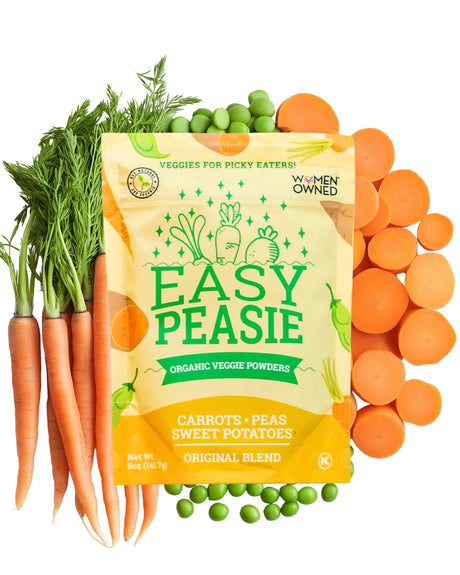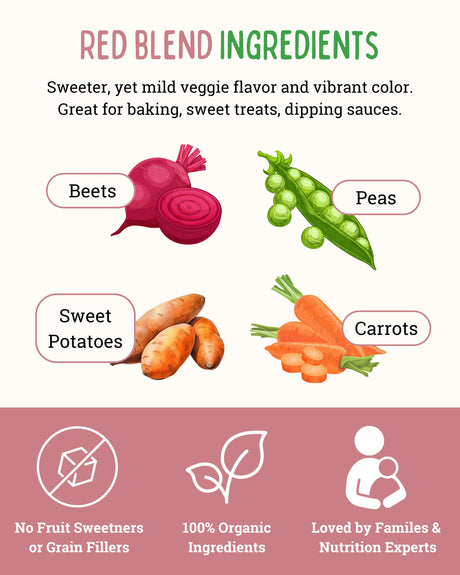Embracing the Holiday Feast with Picky Eaters
The holiday season, brimming with its festive spirit and an array of sumptuous dishes, often brings a familiar challenge for parents: catering to the tastes of picky eaters. The plethora of traditional holiday foods, while a delight to many, can be daunting for children with selective eating habits.
Parents often find themselves at a crossroads, trying to balance the joy of holiday feasting with the concerns of ensuring their child's nutritional needs and meal enjoyment.
Crafting a Kid-Friendly Holiday Menu
This blog aims to provide a guiding light to parents navigating the festive season with picky eaters. Here, we'll explore a range of strategies and tips to make holiday dishes more appealing to children, transforming potential mealtime battles into opportunities for culinary exploration and joy.
From creative presentation techniques to involving kids in meal preparation, we'll delve into practical ways to encourage little ones to broaden their palate. The goal is to ensure that holiday meals are a time of celebration for the whole family, picky eaters included.
Understanding Picky Eaters

The Roots of Picky Eating in Children
Picky eating in children can stem from a variety of reasons, many of which are a normal part of development. For some kids, it’s about seeking control in their environment, and food choices become a place where they can exert this control.
Sensory sensitivities also play a significant role; certain textures, tastes, or smells might be overwhelming to them. Additionally, developmental stages often influence eating habits. Toddlers, for instance, may suddenly become picky as they learn to assert independence.
It’s also worth noting that some children might have had negative experiences with certain foods, leading to hesitance in trying them again.
Patience and Understanding: Key to Navigating Picky Eating
When dealing with picky eating habits, patience and understanding are vital. It’s important for parents and caregivers to recognize that picky eating is often a phase and not necessarily indicative of deeper issues.
Forcing children to eat can create negative associations with food and mealtimes, potentially leading to more profound eating challenges. Instead, adopting a gentle and patient approach, offering a variety of foods without pressure, and respecting the child’s likes and dislikes can create a positive environment.
Understanding and empathy, coupled with consistent exposure to new foods, can gradually encourage children to become more adventurous with their food choices.
Engaging Kids in the Cooking Process

Involving Children in Meal Preparation
Involving children in the cooking process can be a game-changer in addressing picky eating habits. When kids participate in preparing meals, it increases their curiosity and willingness to try new foods.
Being part of the cooking process gives them a sense of ownership and achievement, making them more likely to taste and enjoy the fruits of their labor.
This hands-on experience can transform their perception of food from something they are simply presented with to something they can create and control.
Safe and Fun Kitchen Activities for Kids
There are plenty of ways to safely involve children in the kitchen, depending on their age and abilities. Younger children can start with basic tasks like washing vegetables and fruits, stirring batter, or using cookie cutters on dough.
Older kids can take on more complex tasks such as measuring ingredients, peeling fruits, or assembling dishes. Tasks like decorating cookies or topping a pizza allow them to be creative while learning about different food components.
It’s important to provide them with appropriate kitchen tools and close supervision to ensure their safety and make the experience enjoyable and educational.
Learning Through Cooking
Cooking together provides an excellent opportunity for children to learn about nutrition, different ingredients, and culinary skills. Discuss the health benefits of the ingredients you are using and encourage them to smell, touch, and taste as you go along.
This not only educates them about healthy eating but also makes them more comfortable and familiar with a variety of foods. Simple science lessons can be woven in, such as how heat changes food or why certain ingredients are used in a recipe.
This approach makes cooking an exciting and educational journey, paving the way for a more adventurous and informed attitude towards food.
Making Food Fun
Creative Presentation: The Key to Appealing Meals
The way food is presented can have a big impact on its appeal, especially for picky eaters. Transforming holiday dishes into fun, visually engaging creations can pique a child's interest in trying something new.
For example, shaping mashed potatoes into a snowman or arranging vegetable sticks to form a Christmas tree can make the dish more inviting. Using cookie cutters to create festive shapes out of sandwiches or pancakes adds an element of surprise and delight to the meal.
Colorful and Playful Food Arrangements
Children are naturally drawn to bright colors and interesting shapes. Incorporate a variety of colors in your holiday dishes to make them more attractive to young eyes. For instance, adding cranberries to green leafy salads for a pop of red, or using orange slices and pomegranate seeds as a garnish can create a vibrant and festive look.
Arranging food in a playful manner, like making a face on a plate using different food elements, can turn mealtime into a fun experience for kids.
Themed Meals for Festive Cheer
Utilizing holiday themes can also make meals more appealing to children. Creating a 'winter wonderland' themed breakfast with a snowy yogurt landscape and fruit toppings or a 'Santa's workshop' themed dinner with mini reindeer-shaped meatballs can make the meal more than just eating – it becomes an engaging activity.
These themed meals not only encourage children to try new foods but also help in creating memorable holiday experiences around food.
Reinventing Classic Holiday Dishes
Kid-Friendly Twists on Traditional Recipes
Traditional holiday dishes, while delicious, can sometimes be less appealing to kids. A few tweaks can make these classics more kid-friendly. For example, reinvent the classic green bean casserole by making it with bite-sized beans and a lighter, creamier sauce.
Consider using fun-shaped pasta in your holiday mac and cheese. Transform your holiday turkey into mini turkey meatballs, which can be both fun to eat and easier for little hands to manage.
Healthier, Simpler Holiday Favorites
Simplifying and healthifying popular holiday dishes can make them more suitable for children. For instance, make a healthier stuffing by using whole grain bread, adding chopped apples for sweetness, and reducing the amount of butter.
Sweet potatoes can be mashed with a bit of cinnamon and maple syrup instead of the traditional marshmallow topping. Roasting vegetables like carrots, parsnips, and Brussels sprouts with a touch of honey can bring out their natural sweetness, making them more appealing to kids.
Desserts with a Nutritious Spin
Desserts are a highlight of holiday meals but often loaded with sugar. Modify your dessert recipes to make them healthier and more child-friendly. Baking apple or pear crisps with a sprinkle of oats and nuts offers a sweet treat without excessive sugar.
Mini pumpkin pies or single-serving fruit tarts can be a great way to control portion sizes while still enjoying the festive indulgence. These healthier versions not only cater to kids but also offer the whole family a more nutritious end to the holiday meal.
The Power of Choice and Variety
Empowering Picky Eaters Through Choice
Offering choices can be a powerful tool in encouraging picky eaters to try new foods. When children are given the autonomy to choose from a few options, they feel more in control and less pressured, which can increase their willingness to eat.
For instance, during holiday meals, you can offer two types of vegetables or let them decide between mashed potatoes and sweet potato casserole. This approach not only empowers them but also gently nudges them to make their own decisions about food, fostering a more positive relationship with eating.
Balancing Variety Without Overwhelming
While variety is important, too many options can overwhelm a picky eater. The key is to provide a balanced range of choices without crowding the plate. A good strategy is to have one familiar item that you know the child likes, alongside one or two new or less preferred items.
This ensures that the child has something they can eat comfortably, reducing mealtime anxiety, while also exposing them to new tastes. During the holidays, alongside traditional dishes, include simple, kid-friendly foods to ensure that there’s something on the table for everyone.
Creating a Positive Mealtime Environment
In offering choices and variety, the overall goal is to create a positive and stress-free mealtime environment. Encourage exploration and praise the child for trying something new, but avoid putting pressure or creating a fuss if they choose not to eat certain items.
This supportive and relaxed atmosphere can make mealtimes more enjoyable and increase the likelihood of picky eaters gradually accepting a wider range of foods.
Introducing New Foods Gradually
Ease into New Flavors and Ingredients
Introducing new foods to picky eaters, especially during the holiday season, requires a gradual and patient approach. Begin by incorporating small amounts of new ingredients into dishes they already enjoy. For example, if your child likes mashed potatoes, you might add a small amount of sweet potato to the mix.
Introducing new flavors in familiar contexts can help children become more comfortable with them over time. Remember, the goal is to create positive food experiences, not to overwhelm their senses with too many unfamiliar tastes at once.
Small Bites: Encouraging Without Pressure
When it comes to trying new foods, encourage children to take just a small bite without any pressure or expectation to finish the entire serving. This approach allows them to explore new tastes and textures at their own pace.
During holiday meals, you can offer a "tasting plate" with tiny portions of various dishes. Compliment their willingness to try, regardless of whether they like the food or not. This encouragement can build their confidence in trying new foods and reinforce the idea that it’s okay to have their own preferences.
Patience and Persistence
Patience is crucial when introducing new foods to picky eaters. It’s common for children to need several exposures to a new food before they feel comfortable trying it, let alone liking it. Keep offering the new food in small, non-threatening amounts, without making a big deal out of it. Over time, this consistent exposure can lead to increased acceptance.
The holiday season, with its variety of foods, can be a great opportunity to practice this approach, making it a time of culinary discovery and gentle exploration for your child.
Balancing Nutrition and Pleasure

Crafting Nutritious and Enjoyable Holiday Meals
The holiday season brings a unique opportunity to blend nutrition with pleasure, especially for kids. One effective strategy is to incorporate nutritious ingredients into holiday favorites. For example, adding pureed vegetables into soups or sauces can boost their nutritional value without compromising taste.
You can also make simple swaps like using whole grain bread for stuffing or serving roasted vegetables alongside more indulgent dishes. This approach allows children to enjoy the flavors of the season while still getting the nutrients they need.
A Happy Medium with Holiday Treats
Striking a balance between healthy foods and traditional holiday treats is essential for a holistic approach to meal planning. You don’t have to completely eliminate holiday indulgences; instead, focus on moderation and portion control.
Offer smaller servings of desserts and balance them with healthier options throughout the meal. Encourage kids to try a bit of everything on the table, from the nutrient-rich dishes to the special treats. This way, they can enjoy the festive flavors without overindulging in less nutritious options.
Involving Kids in Healthy Choices
Involve children in making healthy choices by letting them help with meal planning and preparation. When kids take part in choosing and preparing dishes, they're more likely to be excited about eating them.
You can ask them to pick between two healthy options for a side dish or help them prepare a fruit-based dessert. This involvement not only makes mealtime more enjoyable but also teaches them valuable lessons about nutrition and balanced eating.
Dealing with Sweet Treats and Desserts

Healthier Holiday Desserts for Kids
The holiday season often means an abundance of sweet treats, but there are ways to make desserts healthier and still appealing to children. Consider fruit-based desserts, like baked apples or pears, which are naturally sweet and can be spiced up with cinnamon or a touch of honey.
Another idea is to create DIY parfait stations with Greek yogurt, fresh fruit, and a sprinkle of granola, allowing kids to build their own dessert. Miniature versions of traditional desserts can also be a hit – think small pumpkin pies or bite-sized cookies, which not only help with portion control but are fun for kids to eat.
Managing Sugar Intake During the Holidays
Balancing sugar intake during the holiday season is key to maintaining overall health. One strategy is to focus on quality over quantity. Instead of multiple high-sugar options, offer one or two well-made treats that satisfy the sweet tooth without going overboard. It's also helpful to pair sweets with healthy options.
For instance, serve a small slice of pie with a side of fruit, or hot chocolate with a few nuts, to balance the sugar with other nutrients. Encouraging kids to drink water or milk instead of sugary beverages during holiday meals can also significantly reduce their overall sugar intake. Remember, the holidays are a time for celebration, and a little indulgence is okay.
The goal is to enjoy these treats mindfully and in moderation.
Creating a Stress-Free Meal Environment
Cultivating a Relaxed Holiday Atmosphere
Creating a stress-free environment during holiday meals is crucial for both parents and children, especially when dealing with picky eaters. The holiday season should be a time of joy and togetherness, not stress and conflict over food.
Start by setting a relaxed tone at the table. Keep the mood light and conversation enjoyable, steering away from topics that might create tension. Soft background music, festive decorations, and comfortable seating can also contribute to a positive and inviting atmosphere.
Reducing Mealtime Pressure
To reduce pressure around eating, avoid making a big deal about what or how much your child is eating. Praise their good behaviors and choices, but don’t comment on every bite they take or don’t take.
This approach allows children to listen to their own hunger cues without feeling the need to eat to please others. Offer a variety of foods and encourage them to try, but don’t force or bribe them to eat certain items.
Remember, the goal is to create pleasant memories around holiday meals, not to win a battle over food.
Involving Kids in Meal Planning
Another way to reduce stress is to involve children in meal planning and preparation. Let them choose a dish they’d like to have on the menu or help with simple tasks in the kitchen. This involvement gives them a sense of control and pride in the meal, making them more likely to enjoy it.
It’s also an opportunity to teach them about food and nutrition in a hands-on and engaging way.
Maintaining Routine and Flexibility
While the holidays are a time for special treats and meals, try to maintain some sense of routine. Regular meal and snack times can provide a sense of security and normalcy for children amidst the holiday excitement.
At the same time, be flexible and understanding. It’s okay if your child eats a little more or less than usual, or if their eating schedule is slightly off. The key is to keep mealtime positive and pressure-free, focusing on the enjoyment and celebration of the holiday season.
Joyful Holiday Meals for Every Palate
Embracing Strategies for Picky Eaters
Navigating the holiday season with picky eaters can be a challenge, but with the right strategies, it can also be a delightful experience. We’ve explored various methods to make holiday dishes more appealing: involving kids in the cooking process, making food fun and visually engaging, tweaking classic dishes to be more kid-friendly, and introducing new foods gradually.
By offering a balance of nutritious and enjoyable foods, giving children the power of choice, and creating a stress-free meal environment, parents can transform holiday meals into a positive experience for the whole family.
Patience and Creativity: The Parent’s Toolkit
To parents navigating the holiday feast with picky eaters, remember that patience and creativity are your best tools. Each child is unique, and what works for one may not work for another. Be patient as your child explores new foods at their own pace, and don’t hesitate to get creative in the kitchen.
Remember, your attitude towards food and mealtime can significantly influence your child’s relationship with eating. A relaxed and positive approach can make a world of difference.
Celebrating the Season with Healthy, Joyful Meals
As the holiday season unfolds, let’s focus on creating memories that go beyond what's on the plate. It's about the laughter, the stories shared, and the warmth of being together. Healthy, happy meals are those where everyone feels included and at ease, regardless of their food preferences.
This holiday season, let's celebrate with an open heart and a table that welcomes all, creating a festive atmosphere that nurtures both the body and the soul. Here’s to a season filled with joy, love, and delicious, child-friendly meals that bring smiles to everyone at the table.
Leave your comments below; we love to hear from you! And don't forget to follow EasyPeasie for more veggie info and convo on YouTube, Facebook, and Instagram! ~ThePeas













